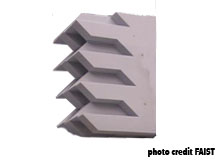In an acoustic test and measurement room, pieces of foam or fibrous material (e.g. mineral wool - rock, glass - or polyester), cut from the mass or obtained from assemblies (of plates), with in some case a support and protection cover (even when there is a perforated sheet at the front) often constitutes an anechoic (i.e. avoiding the reflections of acoustic waves on the surfaces they cover: walls, ceiling, even in somes cases: ground flloring) lining.
In relation to products that can be quite different in how they are made, in shape and in frequency performance - there is usually (at least) this in common among these conventional sound absorbers:
- they are usually designated by the term "wedgel" (regardless of their effective geometry, almost always: angular)
- the lower limit of the frequency domain (often called: cut-off frequency) from which their sound absorption coefficient reaches or exceeds 99%, which is necessary to obtain, inside a room, an acoustic field as free as outdoors - in an unlimited space - (which is precisely the purpose of the implementation of a sound-absorbing lining in a room dedicated to research and development - R&D - in acoustics) is very dependent on their depth e.g. [1] 0.825 m for a cut-off frequency of 100 Hz
This characteristic of their performance poses a problem in different contexts, with regard to the thickness of conventional sound absorbers which would be required to obtain a given cut-off frequency (which must be counted twice when considering the dimensions usable in practice in the experimental chamber between parallel walls having a given spacing):
- where, taking into account the distance required on the one hand between the noise source under test and the microphones, and on the other hand between the microphones and the sound-absorbing coating, it would only allow measurements for a hardware with a size that would be too small compared to that of the hardwarel to be tested indeed
- when it would require a distance between walls greater than what is possible
This is why, whether it is a project to build a new acoustic testing and measurement room, or to retrofit an existing test facility (and then: there is no not uncommon for the search for a lower cut-off frequency to be topical, with respect to what the problem of available space is further increased), an "assymetrically structured absorber"constitutes a particularly suitable sound-absorbing lining since it allows (for cut-off frequency) obtaining:
- 125 Hz for a thickness of 0.53 m
- 100 Hz for a thickness of 0.65 m
- 80 Hz for a thickness of 0.78 m
The asymmetrically structured sound absorbers marketed by ITS (available in 3 thicknesses, as mentioned above) are machined from blocks of non-flammable, light-coloured foam (it is possible to add, at the front, a perforated metal protection).
As their name suggests, asymmetrically structured sound absorbers have an angular corrugation, i.e. a form of regularity in the variation of the thickness of the material, which is different from that - less sophisticated - of conventional wedges.
Such a choice of asymmetrically structured sound absorbers is appropriate in all cases where an absorbent lining with both a very good absorption factor and a thickness less than that of a conventional wedge is required, at a reasonable supply and installation cost: for acoustic testing and measurement rooms such as anechoic or semi-anechoic rooms with which universities, engineering schools and acoustics laboratories are often equipped..
|
|
|
ITS masters all aspects of the choice of an anechoic lining "asymmetrically structured absorber" for an acoustic testing and measurement room.
Spread the word !
